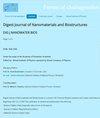用ZnO:Cu薄膜和从贯叶连翘花中提取的染料制备染料敏化太阳能电池
IF 1
4区 材料科学
Q4 MATERIALS SCIENCE, MULTIDISCIPLINARY
Digest Journal of Nanomaterials and Biostructures
Pub Date : 2023-04-20
DOI:10.15251/djnb.2023.181.389
引用次数: 1
摘要
染料敏化太阳能电池(DSSC)是利用纯的和铜掺杂的氧化锌(ZnO:Cu)纳米颗粒以及从干燥的贯叶金丝桃(H.perforatum)花中提取的染料来设计的。采用连续离子层吸附和反应(SILAR)方法在85°C的锡掺杂氧化铟涂层(ITO)玻璃衬底上生长了ZnO:Cu薄膜。关于Cu离子与Zn离子的摩尔比,Cu具有0.5%、1%和2%的掺杂浓度。使用X射线衍射仪(XRD)、扫描电子显微镜(SEM)、能谱仪(EDS)、紫外-可见光谱和傅里叶变换红外光谱(FTIR)研究了合成的ZnO:Cu薄膜的结晶性质、形态、组成和光学性能。SEM结果表明,ZnO:Cu薄膜表面形成了多孔结构,为染料分子和电解质离子提供了更多的活性位点。使用纯ZnO薄膜生产的DSSC显示出7.66mA/cm2的电流密度(Jsc),0.98V的开路电压(Voc)和2.47%的总效率(η)本文章由计算机程序翻译,如有差异,请以英文原文为准。
Dye-sensitized solar cells fabricated using ZnO:Cu thin films and dye extracted from Hypericum perforatum L. flowers
Dye-sensitized solar cells (DSSC) were designed utilizing pure and copper-doped zinc oxide (ZnO:Cu) nanoparticles and the dye extracted from dried Hypericum perforatum L. (H. perforatum) flowers. The ZnO:Cu thin films were grown using the successive ionic layer adsorption and reaction (SILAR) method on tin-doped indium oxide-coated (ITO) glass substrates at 85 °C. Regarding the molar ratio of Cu ions to Zn ions, Cu had a doping concentration of 0.5%, 1%, and 2%. The crystalline nature, morphological, compositional, and optical properties of the synthesized ZnO:Cu thin films were studied using an X-ray diffractometer (XRD), a scanning electron microscope (SEM), energy dispersive x-ray spectrometry (EDS), UV-vis spectroscopy, and Fourier transformation infrared (FTIR) spectroscopy. The SEM results indicated the formation of a porous structure on the surface of ZnO:Cu thin films, which provided more active sites for dye molecules and electrolyte ions. A DSSC, produced by using a pure ZnO thin film, showed a current density (Jsc) of 7.66 mA/cm2 with an open-circuit voltage (Voc) of 0.98 V and an overall efficiency (η) of 2.47%
求助全文
通过发布文献求助,成功后即可免费获取论文全文。
去求助
来源期刊

Digest Journal of Nanomaterials and Biostructures
工程技术-材料科学:综合
CiteScore
1.50
自引率
22.20%
发文量
116
审稿时长
4.3 months
期刊介绍:
Under the aegis of the Academy of Romanian Scientists
Edited by: -Virtual Institute of Physics operated by Virtual Company of Physics.
 求助内容:
求助内容: 应助结果提醒方式:
应助结果提醒方式:


